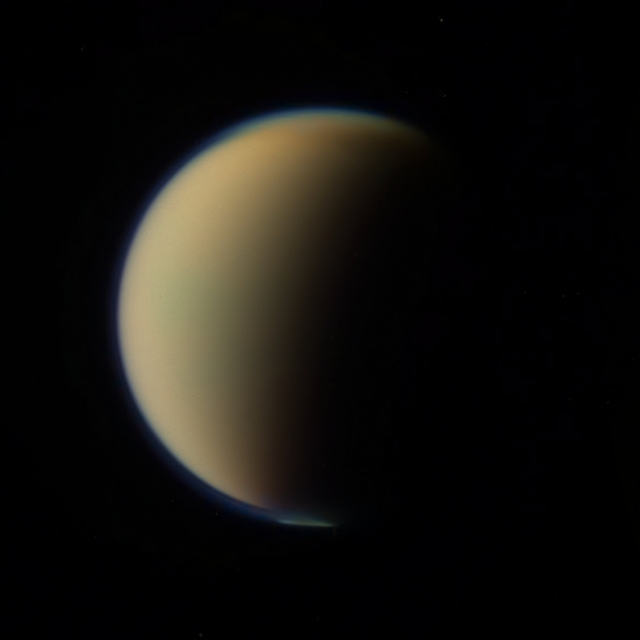
May 31, 2012
Credits: NASA/JPL/Space Science Institute - Credits for the additional process. and color.: Elisabetta Bonora and Marco Faccin/Lunar Explorer Italia/IPF
|
What we see in today's APOD is NOT (in our humble opinion) an high-altitude bright Circular South Polar Cloud, even though it may look like it. In fact, the nature and origin of this phenomenon, which we believe (as IPF) that could be a so-called "Non Organized" (and yet fully localized) Aurora, is still under discussion and no official positions about it have been expressed so far. As far as we know (but the Space Science, as a matter of fact, is a Field of Knowledge that is in continuous evolution), emissions like the one visible in this frame, are supposed to be just similar to Earth's Aurorae, but since Titan (we must repeat: AS FAR AS WE KNOW!) has no Intrinsic Magnetic Field to focus the precipitating electrons at the Poles, the 'Non-Organized Aurorae' may start over the Polar Regions and then arrive to extend, sometimes, over the entire moon. It does not take a genius, however, to see that the phenomenon we are looking at today, is FAR AWAY from being disorganized (uneven) and over-extended. Could this frame, therefore, be the evidence of the existence, around Titan, of a real and stable Magnetic Field? If the answer were "Yes", then what we are looking at now could be the evidence of a discovery of Historical Proportion. If, instead, this phenomenon is just a cloud-related one, then...we apologize for our mistake. However, talking about Titan and as far as simple Clouds are concerned, we can say that in September of the AD 2006, the NASA - Cassini Spacecraft imaged a large Cloud at an height of approx. 40 Km above Titan's North Pole. Although Methane is known to be able to condense in Titan's Atmosphere, the Cloud was more likely to be made of Ethane, as the detected size of the particles was only 1 to 3 micrometers and Ethane can also freeze at such altitudes. In December of the same year, Cassini again observed some Clouds and detected the presence of Methane, Ethane and other organics. The Cloud was over 2400 Km in diameter and was still visible during another Fly-By which occurred over a month later. One hypothesis is that, at the time, it was raining (or, if cool enough, snowing) on the North Pole of Titan; the downdrafts at high Northern Latitudes, in fact, are strong enough to drive organic particles towards the Surface. As you can easily understand, these events were (and are) the strongest evidence yet for the long-hypothesized "Methanological Cycle" of Titan (which is substantially analogous to the Earth's Hydrological Cycle). Clouds have also been seen over the South Polar Regions of Titan though. While typically covering 1% of Titan's disk, outburst events have been observed in which the Cloud Cover rapidly expands to as much as 8%. One hypothesis asserts that the Southern Titanian Clouds are formed when heightened levels of Sunlight - during the Titanian Summer - generate an uplift in the Atmosphere, resulting in a phenomenon of Convection. Such an explanation, though, is complicated by the fact that Cloud formation has been observed not only during the post–Summer Solstice but also at Mid-Spring. Increased Methane humidity at the South Pole may possibly contributes to the rapid increase in the Clouds size. There had been Summer in Titan's Southern Hemisphere (until the AD 2010), when Saturn's orbit, which governs the moon's motion, tilted the Northern Hemisphere towards the Sun.; and when the seasons switch, it is expected that Ethane will begin to condense over the South Pole too. Research models that match well with observations suggest that Clouds on Titan cluster at certain (so-called "preferred") coordinates and that the Cloud Cover varies as its distance from the Titanian Surface changes, on different parts of the moon. In the presso-Polar and Polar Regions of Titan (such as from 60° of Latitude up), widespread and permanent Ethane Clouds have been noticed to appear (and stay) in and above the Titanian Troposphere; at lower Latitudes, instead, mainly Methane Clouds are found between 15 and 18 Km of altitude, and it has been recoreded that they are more sporadic and localized. In the Hemisphere of Titan where it is Summer, frequent, thick - but sporadic - Methane Clouds seem to appear and then to cluster (---> get together) around the 40° of Latitude. Ground-based observations also reveal seasonal variations in the Global Cloud Cover. Over the course of Saturn's 30-year orbit, Titan's Cloud System appears to manifest for only about 25 years, and then it fades (---> disappears) for four to five years, before coming back again. The NASA - Cassini Spacecraft has also detected high-altitude, white, Cirrus-type Clouds in Titan's Upper Atmosphere, likely formed of Methane. (even though the presence of Water-ice particles has not yet been excluded) Although (and contrary to Common Knowledge) no evidence of Lightning Activity has yet been observed on Titan, some computer models suggest that Clouds in the moon's Lower Troposphere could accumulate enough charge to generate Lightnings, possibly from an altitude of roughly 20 Km. This frame has been colorized in Absolute Natural Colors (such as the colors that a normal - meaning "in average" - human eye would actually perceive if someone were onboard the NASA - Cassini Spacecraft and then looked outside, towards the Saturnian moon Titan), by using an original technique created - and, in time, dramatically improved - by the Lunar Explorer Italia Team. |
News visualized: 1057 times

